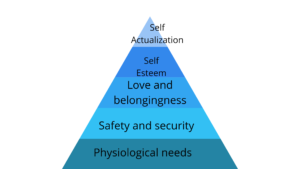Abraham Maslow propounded the hierarchy of needs to explain human motivation towards life’s goals. According to him human beings have various types of needs and they are driven to take action to fulfill these needs.
Maslow categorised these needs and gave them an hierarchy.

An individual first strives to fulfil the needs at the base of the hierarchy and when these needs are fulfilled they move towards the fulfilment of upward higher needs. As per Maslow higher needs cannot be achieved without the fulfilment of lower needs.
Biological needs or physiological needs
As shown in the figure, needs at the base of the hierarchy are hunger, thirst, and satiety of other physical needs. These are also needs based on Id impulses. When these needs are achieved then a person wants to achieve safety and security needs.
Safety and security needs
Every individual wants to feel safe and secure. To achieve this need a person is motivated to take actions for their physical as well as social protection. Physical protection includes housing, safety of life, and social protection includes economic and financial independence, freedom of speech and practice of faith etc.
Love and belongingness:
Humans are emotional and social beings and hence prefer to have healthy interactional patterns with fellow human beings. An individual always strives to be a part of a group , community or society and feel a sense of belongingness to these. Family being the smallest unit which a person likes to associate with. Individuals also want to be loved by others and love someone. This need for love and affection drives a person towards behaviour which would fulfil these needs.
Self Esteem
Once the need of love and belongingness is achieved a person moves towards seeking higher order needs. As individuals are social beings they tend to compare themselves with others and strive to become who is valued in the society. If they feel a sense of self worth then they have a high self esteem. Therefore individuals are motivated to take action towards achieving self esteem needs, such as a reputed profession, success in business, community service etc.
Once self esteem needs are fulfilled, a person moves towards the highest need.
Self Actualization
Self Actualization refers to the state in which a person has fulfilled all the lower order needs or has risen above all needs. In this state a person has no need and it seeks to understand itself as part of the ultimate divine. It is similar to a spiritual state where a person gets detached from worldly affairs and tries to attach meaning to its eternal existence.
According to Maslow, hardly few people are able to reach this state and who teach it become spiritual leaders. Personalities like Buddha, Mother Teresa, saints of Himalayas etc. can be put under this category.
Though Maslow propounded this theory, he stated that most human beings spend their life fulfilling the first three lower needs. Only some are able to reach the point in their life where they have achieved their self esteem needs and hardly anybody reaches Self Actualization.
The hierarchy of needs though gets fulfilled in an order but at times these boundaries are blurred and some may fulfil a higher order need while still pursuing a lower order need. But then that is rare.
Conclusion
The hierarchy of motivation helps a social worker to understand human beings’ needs and their struggle towards achieving their needs. Sometimes conflicting situations to take action for their motivation may occur for which a person may require external help. Social workers may help such clients in light of this need hierarchy.
Further readings:
Morgan & King, Introduction to Psychology. Tata Mc Graw Hills.
